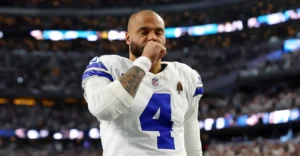Big payday for Dak Prescott? Let him become a free agent in 2025? How will Cowboys handle his contract?
The outcome of Dak Prescott’s deal will determine the Dallas Cowboys’ 2024 offseason.
The quarterback’s $59.4 million salary cap is the second highest in the NFL, only surpassed by Deshaun Watson of the Cleveland Browns.

After the 2020 season, Prescott signed a four-year, $160 million contract with a $126 million guarantee. This is the last year of the agreement.
According to Prescott’s contract, the Cowboys are not allowed to give him the franchise tag in 2025.
In addition, he has a no-trade clause, which essentially limits his trade options to teams he approves of.
Russell Wilson, who was traded from the Seattle Seahawks to the Denver Broncos, also has a no-trade clause.
A revised deal, similar to what happened to enable Aaron Rodgers’ transfer from the Green Bay Packers to the New York Jets,
would be necessary for any such move of Prescott in order to make it more agreeable for the Cowboys against the cap.
For a number of reasons, including the Cowboys’ strong desire to win in 2024 and their belief that Prescott can help them do
it, a trade is still unlikely.
However, the Prescott question is more about 2025 and later than it is about 2024.
Regarding Prescott and his contract, the Cowboys have three choices: take no action, give him voidable years, or sign him to a
large contract extension.
Let’s investigate:
Do nothing
Can the Cowboys carry Prescott’s $59.4 million cap figure in 2024? Yes.
Does that make it more difficult to add players or retain the guys they want to keep? Yes.
But it’s not impossible. And it puts Prescott on the same win-or-else track as coach Mike McCarthy, who is also entering the
final year of his contract.
It also gives Prescott more leverage in negotiations, given that the team can’t tag him in 2025 and he would be facing true
unrestricted free agency for the first time at age 31.
In order to free up roughly $20 million in salary space, the Cowboys already have plans to restructure the contracts of All-Pro
guard Zack Martin and cornerback Trevon Diggs, who is recovering from an ACL tear.
They are also able to rework Terence Steele’s right tackle contract.
They would not add that room until June, but they could gain $9.5 million by designating wide receiver Michael Gallup as a post-June 1 cut.
They can sign All-Pro receiver CeeDee Lamb to an extension that would actually lower his $17.99 million cap figure and make
him the highest-paid receiver in the game.
The cap is not a myth, but there are ways to work around the cap and push dollars into the future.
Add more voidable years
Technically, Prescott is signed through 2026, but the last two years of the deal void at the end of the 2024 season.
The Cowboys can restructure Prescott’s contract again for 2024 and create about $18 million in cap room.
They could create a little more if they converted his $5 million roster bonus. But that would increase the dead money in 2025,
taking it to more than $54 million.
And if the Cowboys sign him to a new deal after the 2024 season, the $54 million would be added into his 2025 cap figure.
The Cowboys can add two more voidable years onto Prescott’s deal in 2024 and create even more cap space this year,
but the same dead money would be on the books for 2025.
Adding more voidable years would allow the Cowboys to make 2024 an all-in season by spending money in free agency,
but it would make things prohibitive in 2025 and beyond.
When a Super Bowl drought closes in on three decades, fans would be willing to do just about anything if it
means having a better chance of winning a Vince Lombardi Trophy.
Sign Prescott to an extension
By signing Prescott to an extension of four, five or six years, depending on what the quarterback would agree to, the Cowboys
will have fixed costs at the quarterback position, which is always a good thing when the numbers get this large.
And it would give them short-term salary cap relief.
In 2021, it took the Cowboys a long time to sign Prescott. In 2019, they believed they had reached an agreement,
but they never actually communicated again.
The story that is often told is not that they did not attempt to sign Prescott.
Prescott opted to postpone. Despite suffering a devastating injury to his right ankle, he played for a year on the
franchise tag and earned everything he wanted in his new contract.
Theoretically, he is in that position again because the Cowboys can’t use the franchise tag.
And now quarterback contracts have soared to an average of more than $50 million per year.
At $40 million, Prescott’s annual salary (as opposed to his salary cap hit) is tied for 10th highest among quarterbacks.
Joe Burrow is atop the market at $55 million. He has gone to a Super Bowl and two AFC Championship Games.
Prescott is still waiting to play in his first NFC Championship Game despite starting eight seasons.
Despite having already won two MVP awards, Peyton Manning made his Super Bowl debut in his tenth season.
In his eighth season with the Atlanta Falcons, Matt Ryan attended his first—and only—game.
Only Ken Anderson of the Bengals started ten seasons before winning his first Super Bowl since 1980.
In his tenth season, is Prescott able to defy the odds and reach one?
It seems from history that the answer is no.
The Cowboys must also ask themselves if they would be paying Prescott out of obligation or out of want.

Leave a Reply